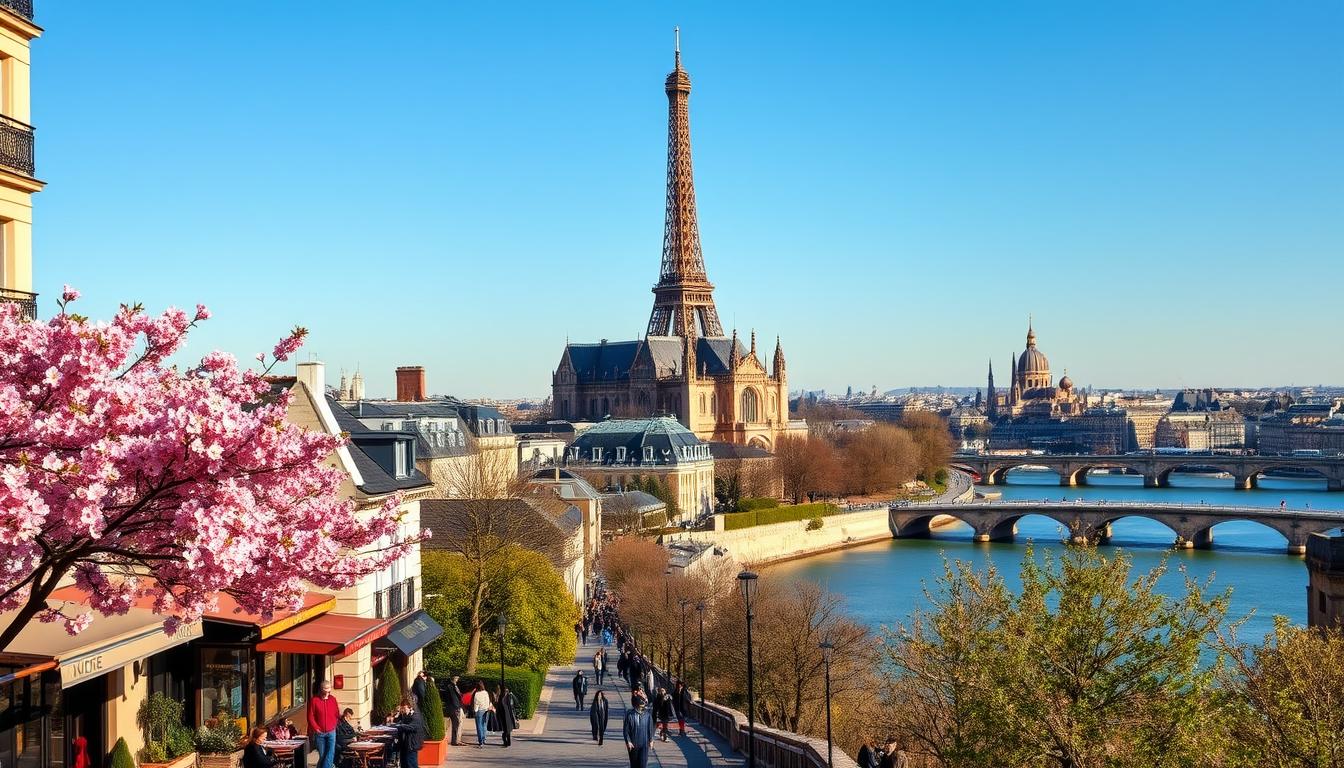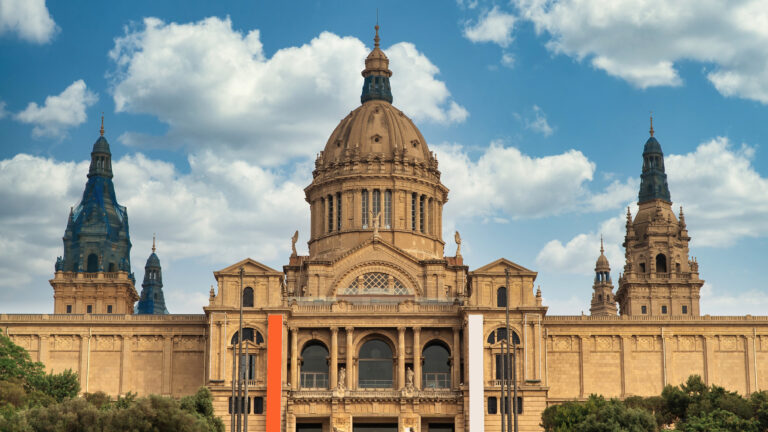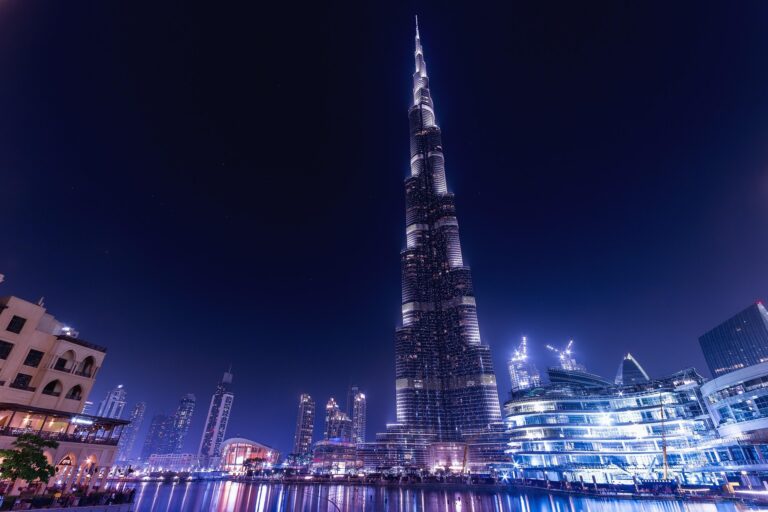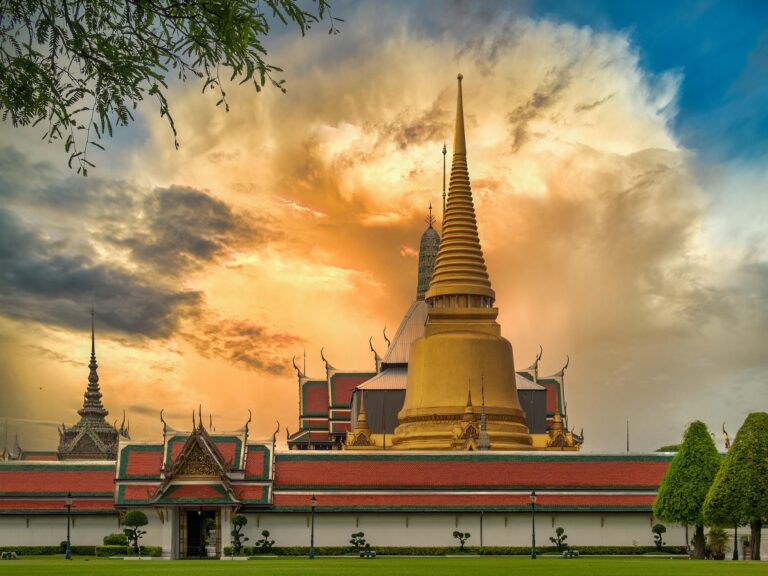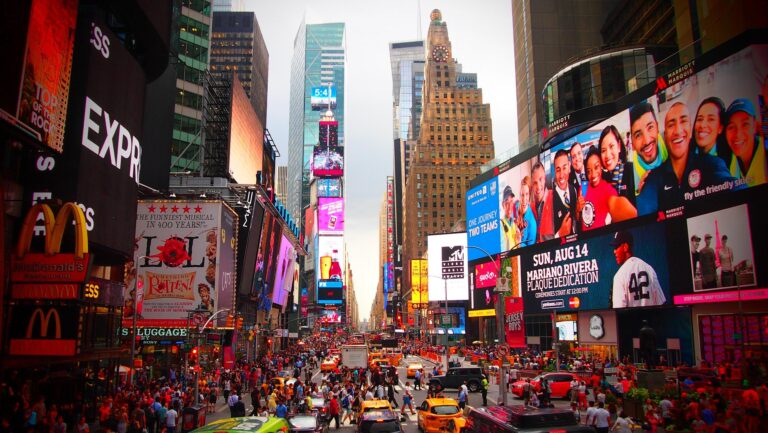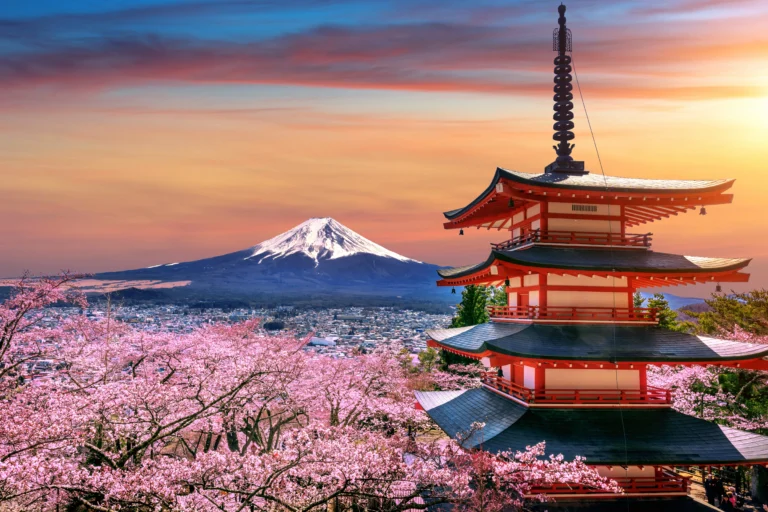BEST TIME TO VISIT PARIS
I still remember my first trip to Paris, the City of Lights, and how the mild spring weather added to its enchanting beauty.
Planning a trip to this iconic travel destination can be overwhelming, but timing your visit right can make all the difference. With over 22 million tourists annually, the crowds can be intimidating, but visiting during the spring (April-May) or autumn (September-October) can provide a more relaxed experience.

During these periods, the weather is mild, and the city’s charm is on full display. As you plan your travel to Paris, consider these seasons for an unforgettable experience.
The Seasonal Charm of Paris
Paris, with its rich history and cultural heritage, remains a top tourist destination across all seasons. I have always been fascinated by how this city’s charm evolves throughout the year, offering something unique for every visitor.
What Makes Paris Special Year-Round
The city’s timeless beauty is one of its most captivating features. Iconic landmarks like the Eiffel Tower and Notre-Dame Cathedral are always a draw, regardless of the season.
Iconic Landmarks Throughout the Seasons
Spring brings blooming gardens around these landmarks, while summer offers long days to explore. Autumn brings a golden glow, and winter wraps the city in a magical atmosphere.
Paris is not just about its landmarks; it’s also a city of rich cultural experiences. From world-class museums like the Louvre to charming street performers, there’s always something to enjoy. Visitors can indulge in French cuisine, visit historic sites, or simply enjoy the city’s ambiance.
Spring in Paris: Blooming Beauty (March-May)
The City of Light is particularly enchanting during spring, with its parks and gardens in full bloom. As the chill of winter dissipates, Paris awakens with vibrant colors and a renewed sense of life. It’s an ideal time to explore the city’s outdoor attractions, such as the Eiffel Tower and the beautiful gardens along the Seine.
Weather Patterns and What to Pack
Spring in Paris is characterized by mild temperatures, ranging from cool mornings to pleasant afternoons. Understanding the weather patterns is crucial for packing appropriately.
Temperature Ranges and Rain Expectations
During March, temperatures gradually rise, with averages ranging from 42°F to 58°F (6°C to 14°C). April and May see further warming, with temperatures between 50°F to 68°F (10°C to 20°C). However, spring showers are common, so it’s wise to pack an umbrella or raincoat.
Essential Spring Packing List
- Layers for varying temperatures
- Comfortable walking shoes for exploring the city
- Rain gear (umbrella or raincoat)
- Light jacket or sweater for cooler mornings and evenings
Visiting iconic sites like the Louvre Museum is a must, and spring’s pleasant weather makes it an ideal time for a stroll through the museum’s outdoor spaces or a picnic in the nearby Tuileries Garden.
Summer in Paris: Peak Season (June-August)
The summer months are when Paris truly comes alive, with its beautiful parks, outdoor cafes, and river Seine cruises. As I strolled along the Seine River, I was captivated by the city’s charm and vibrancy.
Summer Weather and Essentials
Summer in Paris is characterized by warm weather, with average highs often reaching the mid-70s to mid-80s Fahrenheit (23-30°C). It’s essential to pack accordingly.
Heat Waves and How to Prepare
Paris can experience heat waves during the summer. To stay cool, I recommend:
- Staying hydrated by drinking plenty of water
- Seeking shade, especially during the hottest parts of the day
- Taking breaks in air-conditioned spaces like museums or cafes
Summer Packing Guide
When packing for summer in Paris, consider bringing:
| Item | Description |
|---|---|
| Lightweight clothing | Breatheable fabrics like cotton or linen |
| Sunscreen and sun hat | Protect yourself from the sun’s strong rays |
| Comfortable shoes | For walking along the Seine River or exploring the city |
Summer is also the perfect time to indulge in French cuisine at outdoor cafes or enjoy a leisurely dinner cruise on the Seine River. Don’t miss the opportunity to savor the flavors of France while taking in the city’s picturesque views.
With its long days and warm weather, summer is an ideal time to explore all that Paris has to offer, from its culinary delights to its scenic riverbanks.
Fall in Paris: Golden Elegance (September-November)
As the summer crowds dissipate, Paris transforms into a serene autumnal haven. The city’s foliage is particularly beautiful during this time, with the changing leaves adding a warm, golden hue to its historic landscapes.
Autumn Weather and Packing Tips
The fall season in Paris is characterized by mild temperatures, ranging from cool mornings to pleasant afternoons. It’s essential to pack layers for your trip, as the temperature can fluctuate significantly throughout the day.
Temperature Shifts and Layering Advice
During the fall, the average high temperature is around 64°F (18°C), while the average low is about 48°F (9°C). To be prepared, pack clothing that can be layered, such as lightweight sweaters, scarves, and waterproof jackets.
Rain Preparation
Fall can also bring occasional rain showers to Paris. It’s a good idea to bring an umbrella or a raincoat to keep you dry. Additionally, consider packing waterproof shoes or boots to ensure you’re prepared for any wet conditions.
Visiting Paris in the fall allows you to enjoy the city’s attractions without the peak season crowds. You can take a leisurely stroll along the Seine, visit famous landmarks like the Eiffel Tower, and explore the city’s charming neighborhoods, such as Le Marais and Montmartre.
The fall season is also a great time to experience Paris’s cultural events and festivals. For instance, the Nuit Blanche art festival usually takes place in October, where museums and cultural institutions stay open late into the night, offering a unique glimpse into the city’s vibrant art scene.
Winter in Paris: Magical Atmosphere (December-February)
The winter season brings a unique tranquility to Paris, making it an ideal time to explore its famous landmarks. As I wander through the city, I’m struck by the serene atmosphere and the way the cold weather adds a touch of magic to the iconic Eiffel Tower and other famous sites.
Weather Considerations
Winter in Paris is characterized by cold temperatures and occasional snowfall. It’s not uncommon for the temperature to drop below freezing, so it’s essential to pack warm clothing.
Cold Temperatures and Occasional Snow
Temperatures can fluctuate, but it’s generally chilly, with average highs around 8°C (46°F). Snow is not frequent but can add to the city’s charm when it does snow.
Winter Wardrobe Essentials
To enjoy Paris in winter, you’ll need a warm coat, gloves, a hat, and a scarf. Thermal layers are also a must to keep you cozy while exploring the city’s outdoor attractions.
| Month | Average High | Average Low |
|---|---|---|
| December | 8°C (46°F) | 3°C (37°F) |
| January | 7°C (45°F) | 2°C (36°F) |
| February | 9°C (48°F) | 3°C (37°F) |
Despite the cold, winter is a great time to visit popular landmarks like the Eiffel Tower without the crowds, making for a more intimate and peaceful experience.
Paris Through the Year: Month-by-Month Guide
Visiting Paris is a year-round experience, with each month offering a unique charm. As we explore the city month by month, we uncover the diverse attractions and events that make Paris a perennial favorite among travelers.
January-March: Winter Winding Down
The early months of the year bring a serene beauty to Paris, as the city slowly awakens from its winter slumber.
Post-Holiday Atmosphere
January is characterized by a post-holiday calm, with many Parisians returning to their daily routines. It’s a great time to visit popular attractions like the Louvre Museum without the crowds.
Winter Sales (Soldes)
February marks the beginning of the winter sales, or “soldes,” where you can find great deals on French fashion and cuisine-related items. Enjoying a cup of coffee at a charming café along the Seine River becomes even more delightful during this period.
As March arrives, the city starts to feel the onset of spring, with the weather gradually becoming milder.
| Month | Weather | Events/Attractions |
|---|---|---|
| January | Cold | Post-holiday calm, fewer tourists |
| February | Cold | Winter sales (Soldes) |
| March | Mild | Onset of spring, Easter events |

Indulge in the rich flavors of French cuisine at one of the many bistros or fine dining establishments. Whether you’re strolling along the Seine or exploring the city’s historic quarters, Paris in the early months of the year has its own unique allure.
Exploring Paris on a Budget: When to Save
I discovered that traveling to Paris during the off-season can be a cost-effective option. The city’s charm is still palpable, even when the crowds are smaller.
Low Season Price Advantages
Visiting Paris during the low season, typically from November to March, offers several financial benefits. The prices for accommodations and flights tend to be lower, making it an ideal time for budget-conscious travelers.
Accommodation Discounts
During the low season, many hotels and hostels offer discounts to attract visitors. This can result in significant savings, especially for those who book in advance. Booking early can lead to discounts of up to 20% or more on accommodation prices.
Flight Price Patterns
Flight prices to Paris also follow a pattern, with prices generally being lower during the off-peak season. Being flexible with your travel dates can help you snag a cheaper flight. Using flight comparison tools can also aid in finding the best deals.
By planning your trip to Paris during the low season, you can enjoy the city of lights without breaking the bank. With accommodation discounts and cheaper flights, your travel budget can stretch further.
Hidden Gems in Paris: Seasonal Secrets
As I wander through the streets of Paris, I discover that the city’s charm lies not only in its famous landmarks but also in its hidden gems. While many flock to the Eiffel Tower and Louvre, the true essence of Paris can be found in its lesser-known attractions, which change with the seasons.
Spring Hidden Gems
Spring in Paris is a time of renewal, and the city comes alive with vibrant colors and festivities. Two of the most enchanting aspects of spring in Paris are its lesser-known flowering gardens and neighborhood spring festivals.
Lesser-Known Flowering Gardens
While the Luxembourg Gardens are a popular destination, there are other hidden gardens that are equally beautiful. The Jardin des Plantes is a botanical garden that houses a variety of plant species and a small menagerie. It’s a serene escape from the bustling city.

Paris’s neighborhoods host various spring festivals, showcasing the city’s cultural diversity. The Fête de la Nature in the Parc de Bagatelle is a celebration of nature, with music, food, and activities for all ages. It’s a wonderful way to experience the local culture.
Exploring these hidden gems not only enriches your visit to Paris but also provides a unique perspective on the city’s tourism industry. By venturing off the beaten path, you can discover the authentic charm of France’s capital city.
Planning Your Perfect Paris Itinerary
To experience the best of Paris, understanding the optimal time to visit and plan accordingly is crucial. The City of Light offers a unique experience across different seasons, making it essential to tailor your trip to maximize your enjoyment.
How Many Days to Spend Based on Season
The ideal duration of your Parisian getaway largely depends on the season. For instance, spring and autumn are ideal for exploring the city’s famous landmarks like the Eiffel Tower and Louvre Museum without the peak season crowds.
Optimal Trip Length for Each Season
For spring (March to May) and autumn (September to November), a 5-day trip is ideal, allowing you to enjoy the city’s beauty and major attractions at a leisurely pace. In contrast, summer might require a longer stay due to the peak tourist season, while winter could be enjoyed in a shorter, more focused trip.
| Season | Optimal Trip Length | Highlights |
|---|---|---|
| Spring | 5 days | Blooming gardens, French cuisine in outdoor cafes |
| Summer | 7-10 days | Beach days along the Seine, outdoor festivals |
| Autumn | 5 days | Nautre’s colors, wine harvest season |
| Winter | 4 days | Christmas markets, ice skating rinks |
Seasonal Day Trip Options
Regardless of the season, Paris offers numerous day trip options. In the spring, visit the Palace of Versailles. Summer is ideal for a river cruise or a visit to the Champagne region. Autumn invites a trip to the vineyards, while winter is perfect for a cozy day trip to Reims or Disneyland Paris.
By tailoring your Paris itinerary to the season, you can ensure a more enjoyable and stress-free trip, making the most of what this beautiful city has to offer.
Conclusion: My Personal Recommendation for Visiting Paris
As I’ve explored the charm of Paris throughout the year, I can confidently say that the City of Lights is a year-round destination. Whether you’re strolling along the Seine River during spring or marveling at the magical atmosphere in winter, Paris has something unique to offer in every season.
For me, the best time to visit Paris is during the fall season, when the weather is mild and the city’s golden elegance is on full display. The autumn foliage adds a picturesque touch to the city’s already breathtaking landscapes, making it an ideal time for sightseeing and exploration.
Regardless of when you visit, Paris is sure to captivate your heart with its rich history, art, fashion, and cuisine. So, pack your bags, grab your camera, and get ready to experience the magic of Paris for yourself.

